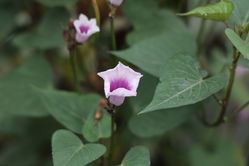 Sweet potatoes, Ipomoea batatas, are one of the most important crops internationally. In terms of yield, they rank number 15 among all crops, and among the root crops they are in 3rd place after potatoes and cassava. Their genetic origin and thus the place of greatest diversity is in subtropical to tropical Central America, but there are also genetic centres in South America (Peru) and in Polynesia, where the large tuberous roots stopped on their journey around the world. Exactly how sweet potatoes reached Polynesia is still not entirely clear. What is certain, however, is that the Maori had been cultivating and eating sweet potatoes for a long time when Captain Cook discovered New Zealand. Obviously, Ipomoea batatas had made progress in the Pacific after all.
Sweet potatoes, Ipomoea batatas, are one of the most important crops internationally. In terms of yield, they rank number 15 among all crops, and among the root crops they are in 3rd place after potatoes and cassava. Their genetic origin and thus the place of greatest diversity is in subtropical to tropical Central America, but there are also genetic centres in South America (Peru) and in Polynesia, where the large tuberous roots stopped on their journey around the world. Exactly how sweet potatoes reached Polynesia is still not entirely clear. What is certain, however, is that the Maori had been cultivating and eating sweet potatoes for a long time when Captain Cook discovered New Zealand. Obviously, Ipomoea batatas had made progress in the Pacific after all.
The European conquerors of Central and South America, especially the Spanish and the Portuguese, then spread the tubers very quickly in Africa, and in Southeast Asia, China and Japan, where they are now most widespread and are part of the natural daily diet and used as a raw material for various foods, also as animal feed (the tuberous roots and the immense shoots and leaves). China is by far the largest producer of sweet potatoes (with about 60% of the world’s total), followed by some African countries, with Nigeria and Malawi at the top.
But how can the sweet potato become native or even more native in European gardens and for European horticultural purposes? This is the initial question to which we would like to lay out some answers in this article. In doing so, we also show the first results of from the Lubera sweet potato breeding programme.
Why we grow sweet potatoes at Lubera...
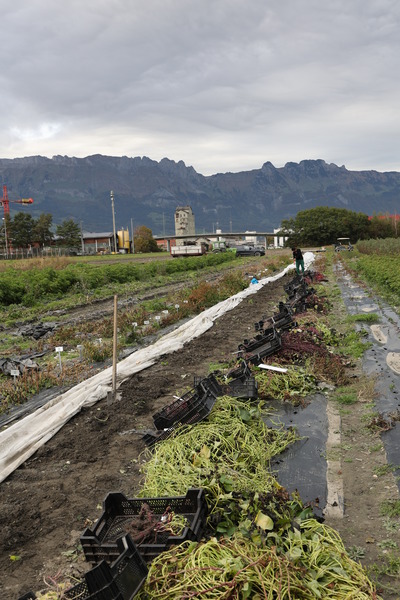
Picture: The breeding field at Lubera with the current sweet potato seedlings (here directly after harvesting).
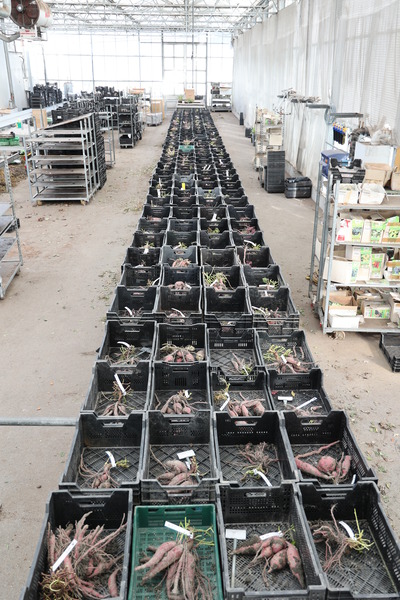
Picture: Sweet potatoes as far as the eye can see - this year's seedlings are waiting to be evaluated.
Let's start with the basics: for food security reasons, it is certainly interesting to develop a second important root crop for Europe alongside the dominant potato. However, our goals are not quite so ambitious: we are happy and satisfied if the Lubera breeding programme succeeds in establishing the sweet potato more firmly in gardens and in niche cultivation – and in making it fitter for European or, more precisely, Central European environmental conditions. However, breeding is not only about the plant itself, but ultimately about its relationship to the consumer and the gardener. Here Ipomea batatas certainly has a starting advantage since the leaves, leaf colours and leaf shapes and partly also the flowers have an enormous ornamental value that makes their use in the garden even more interesting.
Sweet potato breeding for the West, i.e. for North America and Europe is dominated by LSU, Louisiana State University. Most of the varieties currently grown in Europe come from Don Labonte, the LSU AgCenter scientist that breeds the sweet potatoes. The influence of the American market is clearly visible: it seems to be a main goal of breeding to make the sweet potato more potato-like; the sugar is reduced and one of the main objectives is to breed varieties that absorb less fat during frying.
As a basic hypothesis for our breeding, we see the sweet potato for the garden and for niche cultivation rather as a high quality, unique and extremely versatile vegetable, which we want to give as much individuality and diversity as possible: different colours, in the skin and flesh, in the aromas and tastes that we do not yet know from these root vegetables.
The goals of sweet potato breeding for the European garden
But what exactly do we want to achieve with breeding at Lubera, and is it at all possible to adapt the sweet potato, a subtropical to tropical plant, even more to the moderate northern climate zones? Fortunately, the sweet potato basically shows a strong plant-environment dependency compared to other cultivated plants, but thus also a surprisingly great adaptability. This is certainly also due to the genetic structure of the sweet potato, which is hexaploid, i.e. has a six fold set of chromosomes. This makes targeted breeding according to Mendelian rules, planned down to the last detail, almost impossible; conversely, however, one must also see this genetics as an opportunity, as a possibility: in sweet potato breeding, we are ultimately operating a gigantic random generator that constantly throws the genes organised on six strands together anew and generates an infinite number of unpredictable combinations that can then be tested for their suitability – for the garden and for the northern temperate climate. Travelling from Central America via South America, Polynesia, New Zealand, China and Japan and back to Europe, Ipomoea batatas has already proven many times that almost anything is possible with this plant.
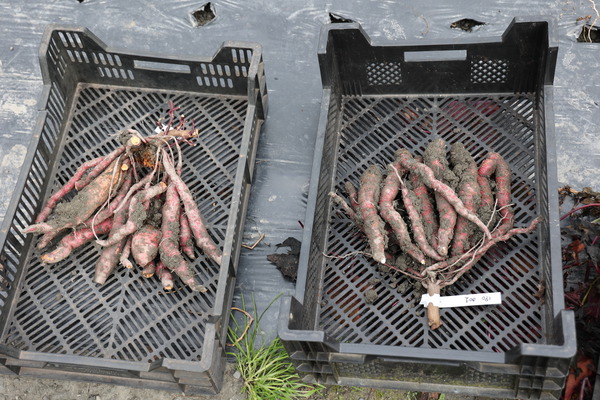
Picture: You only find out what comes out of breeding after the harvest - the very first harvested plants this year don't look too bad at all
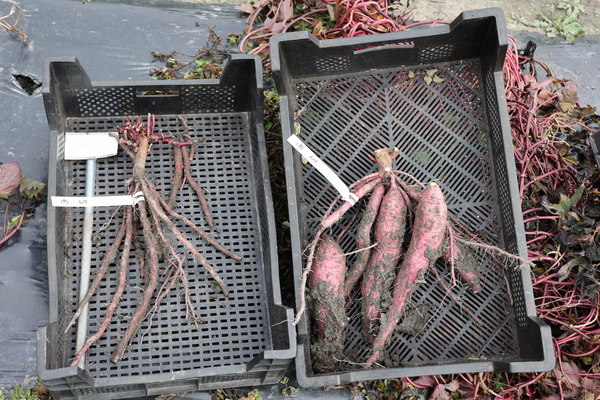
Picture: There is also such a thing in breeding, two completely different appearances from the same cross.
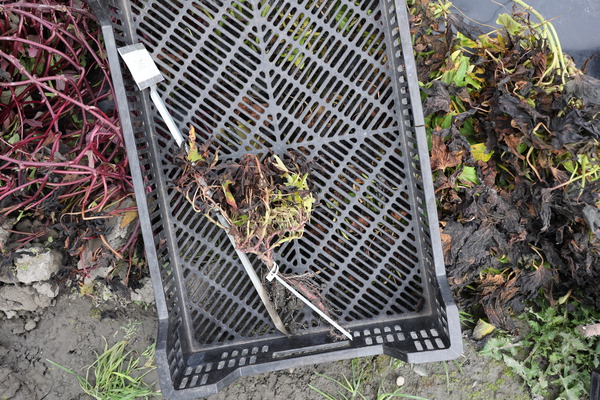
Picture: Compact growing varieties are also interesting in sweet potatoes - you can see the whole plant as it developed within 5 months after planting - this one is not interesting though, as there was no useful yield.
Specifically, we are interested in the following goals in sweet potato breeding:
- Adaptation to the central European, temperate to northern climate. Louisiana, the home of most of the current varieties, has an average annual temperature of about 18°C. The average temperature here is about 10°C.
- Diversity of growth and leaf shapes (ornamental value) and diversity in fruit colours and fruit flavours.
- The tendency is not to move the sweet potato towards the potato (as a starchy staple), but rather away from it: a sweet potato should be sweet and melting in texture, not mealy and bursting with starch.
- Enhancing the healthy ingredients, the carotenoids (yellow, orange varieties) and the anthocyanins (red pigments) as well as the accompanying ingredients, while maintaining a high tasting quality. We do not want to cultivate a useful plant as a medicine, but a plant for enjoyment that can also have positive health effects.
- An efficient leaf-fruit ratio: both for growing in small home gardens and in pots on balconies and terraces, it is desirable to somewhat limit the immense vegetation of the sweet potato. It would be ideal if we could find varieties that are as root productive as the yielding varieties, even with less foliage. Incidentally, the same need also exists in commercial cultivation, where the leaf mass and shoot expansion can interfere with cultivation measures.
- Sweet potato tubers are lateral storage roots, usually originating from the nodes of the main underground axis of the sweet potato plant where they thicken to form a tuberous organ. Visually, you can well imagine this as a kind of banana tuft that develops underground. We want these storage roots to develop as compactly as possible on the main axis, to be smooth and uniform, not to form any further roots and not to branch out further. The break to the underground main axis should be as small and delimited as possible in order to minimise the risk of rot.
- Shelf life: unfortunately, sweet potatoes do not have the best shelf life. Only with a complex curing process (warm storage at the beginning of the storage period to strengthen the cork layer of the fruit skin and thus improve the protection of the root tuber) do they develop a thicker skin, with which they can then be stored longer. However, since they are usually consumed quickly in the home garden and since early varieties can also be continuously harvested and processed from mid-September until November, this is not our first priority for the time being.
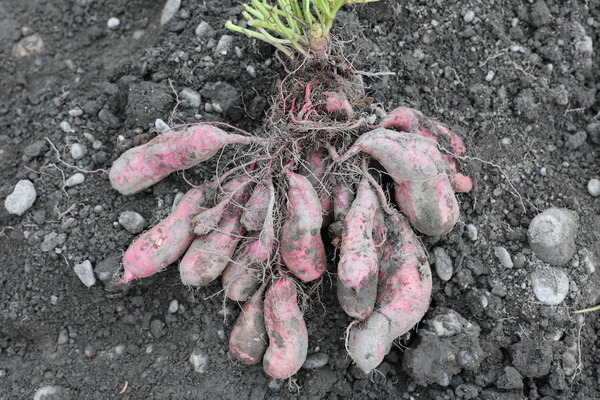
Picture: This is what the result should look like! A large number of medium-sized tubers that are nicely distributed under the plant and are only connected to the root at a small point.
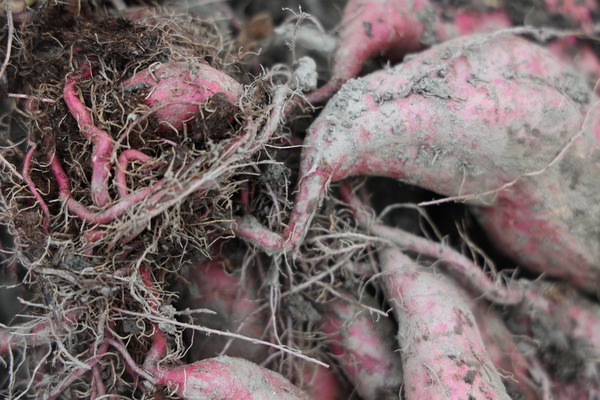
Picture: The predetermined breaking point between the actual storage tuber and the plant.
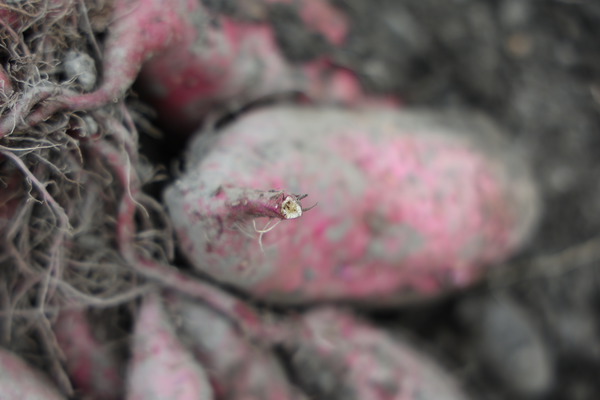
Picture: Ideally, there is only a small injury when separating the tuber from the plant
Difficulties in sweet potato breeding
Per aspera ad astra – only through difficulties can one reach ambitious goals and the stars. Of course, this also applies to sweet potatoes: I have already mentioned the complicated genetic structure with the 6-fold chromosome set. In addition, most genotypes and varieties of Ipomea batatas are self-fertile; on the one hand, this has the advantage of increasing diversity (because fertilisation and seed formation are only possible through foreign pollen); on the other hand, selfing and thus the development of inbred lines is very difficult. When we started breeding sweet potatoes a few years ago, however, a bigger, much more practical obstacle soon became apparent: as already mentioned above, sweet potatoes originate from Central America and South America, i.e. like many other South American root crops, ultimately from the equatorial region with a regular short day of 12 hours. For us, this means that the sweet potato flowers mainly in the short day, i.e. in autumn, when the seeds can hardly ripen.
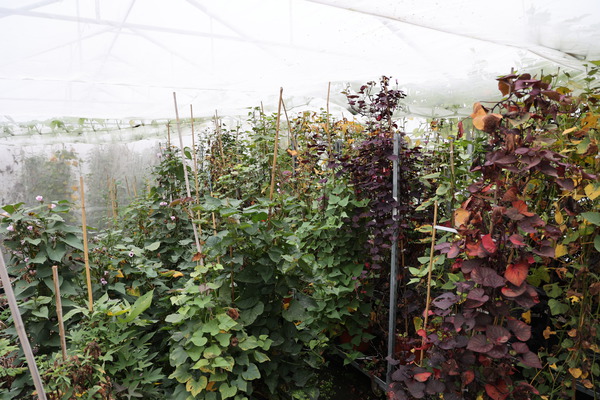
Picture: Sweet potato breeding at Lubera in an insect-proof environment, the only way to carry out deliberate and controlled crossing.
In addition, there is another difficulty: the domestication of the sweet potato has naturally favoured the formation of the underground reproductive organs, the storage roots, and this has tended to be at the expense of the above-ground reproductive organs, the flowers. Many sweet potato varieties are therefore basically reluctant to produce flowers and produce only a few. We can observe this effect more often in cultivated plants, which have two different main strategies for survival. If one strategy is given preferential treatment and strengthened by domestication, the second strategy becomes stunted, which in our case is the ability to reproduce via sexual reproduction, form flowers pollinate the flowers and develop seeds.
In any case, this was one of the most important hurdles our breeder Moritz Köhle had to overcome when starting the sweet potato programme; meanwhile, he gets the vast majority of our assortment of almost 40 varieties to flower and also to produce germinable seeds. We also know exactly where to look for Moritz when we need him: there is a very good chance that he is in the greenhouse caressing and fertilising the sweet potato flowers, which are only one day old...
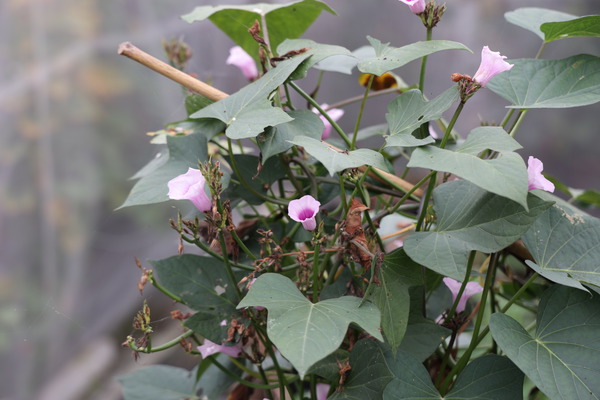
Picture: Our breeder Moritz Köhle has managed to get almost all sweet potato plants to flower
Sweet potato diversity – in terms of growth, leaf shapes and leaf colours
It is a real and lasting pleasure to walk through the seedling rows of sweet potatoes already in the summer and early autumn. What a diversity of leaf colours, shoot colours and growth forms. There really are varieties/genotypes that grow only 30-40 cm, but there are also a majority of the candidate varieties that quickly overgrow 1 m² of land and more (and thus take over the weed control themselves). Based on our first results, it will be possible to develop even higher-yielding ornamental varieties or, even better, to equip the high-yielding varieties with additional ornamental features in the foliage.
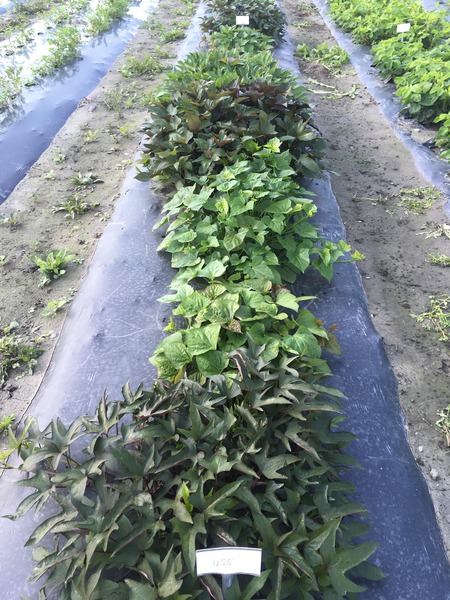
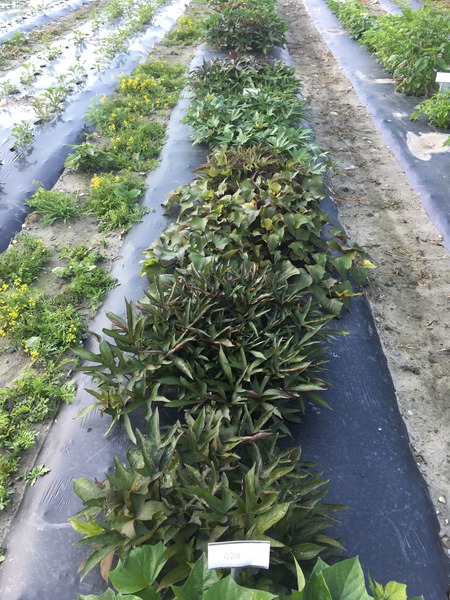
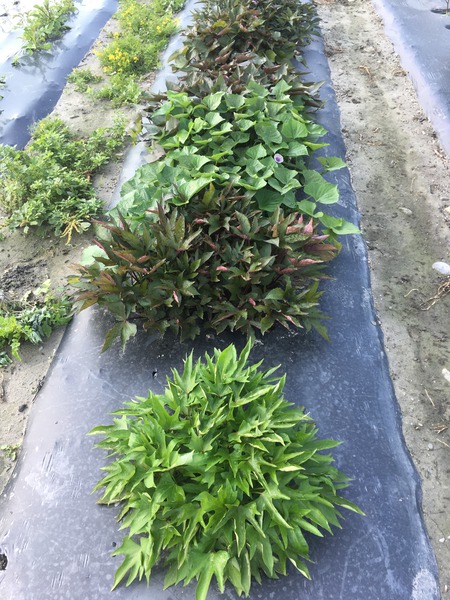
Pictures: The diversity within a seedling population is also already enormous, almost every plant looks different.
Roots and rootlets
The sweet potato tubers are ultimately just thickened storage roots that develop alongside the fine roots that are responsible for supplying water and nutrients. They usually develop from the nodes of the underground shoot axis of the sweet potato. The most beautiful and also the best to harvest and process are medium-sized, elongated to oval roots that start near the base of the plant and hang almost like a banana panicle from uprooted plants and the root stalk. In this way, they can be easily separated and processed with little effort. Such a root crop structure also has the advantage of allowing quite close plant spacing and reducing the predetermined breaking points (and thus the entry ports for diseases.
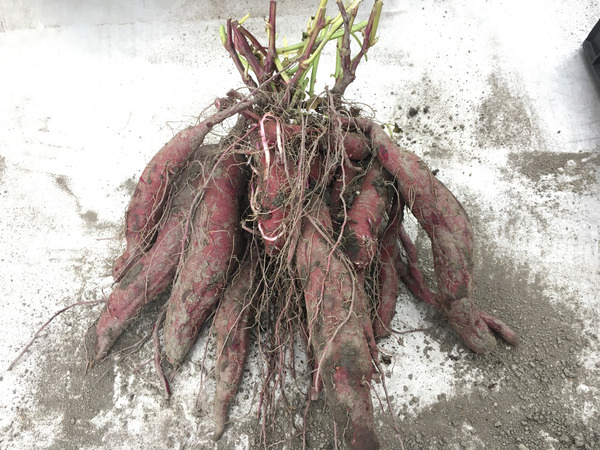
Picture: Optimal root system - few fine roots with well-developed tubers.
In a breeding population, however, anything but the desired root structure and arrangement can of course be observed: there are genotypes that only form fine roots and refuse to form storage roots; there are genotypes that only form the intermediate form of pencil roots, others form tubular, overlong storage roots that are also not ideal for harvesting and processing.
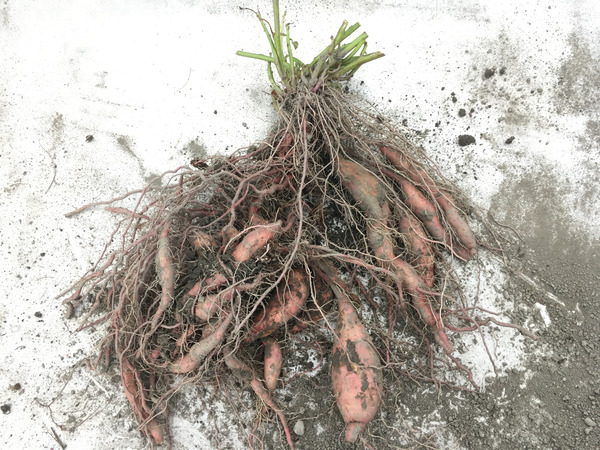
Picture: Suboptimal root pattern - many fine roots with few, underdeveloped tubers.
Sweet potato diversity in the skin colour and flesh colour
In the sweet potato (similar to the potato), the skin colour and the flesh colour are genetically controlled separately to a large extent. It is therefore quite possible or even probable to find an externally red-purple tuber with purple flesh. On the outside as well as on the inside, there are almost all shades from white, cream, yellow, orange, orange-red to dark purple. In addition, there are also mixed colours or flesh structures where the outer and inner layers have different colourings (also similar to the potato). Besides diversity and variety, we would like to develop better tasting, higher yielding and also more diverse tasting purple varieties since the anthocyanins have a high health value (oxidation inhibitors).
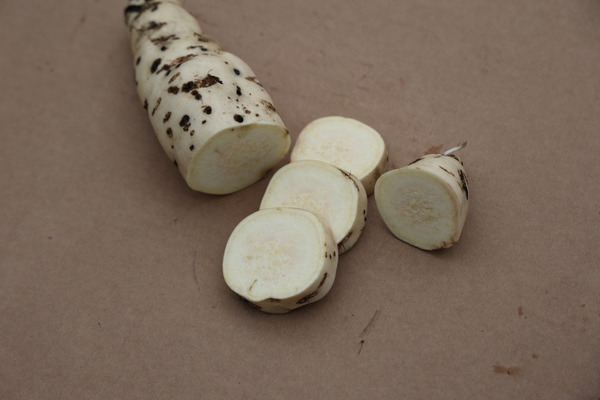
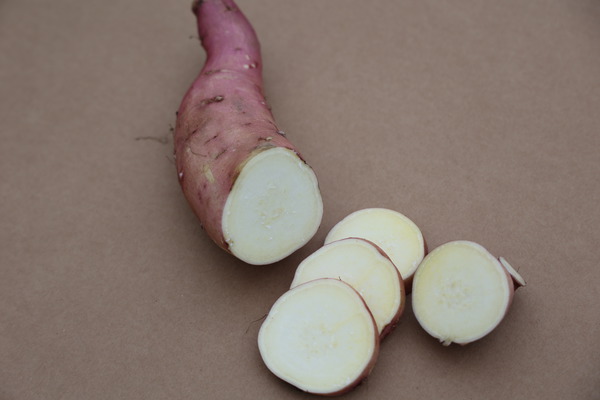
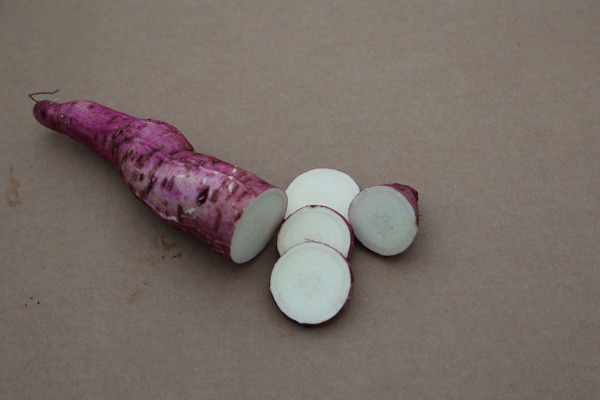
Pictures: The variety of colours of white-fleshed sweet potatoes - although all selections shown are white inside, the colour of the skin varies quite a lot
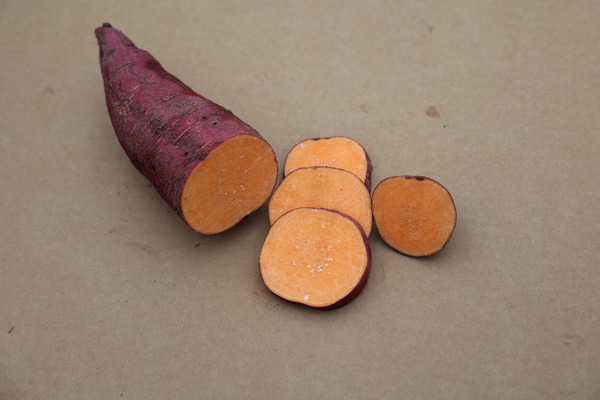
Picture: Who would have thought that such an intensely red-purple skin would conceal such an intensely orange tuber?
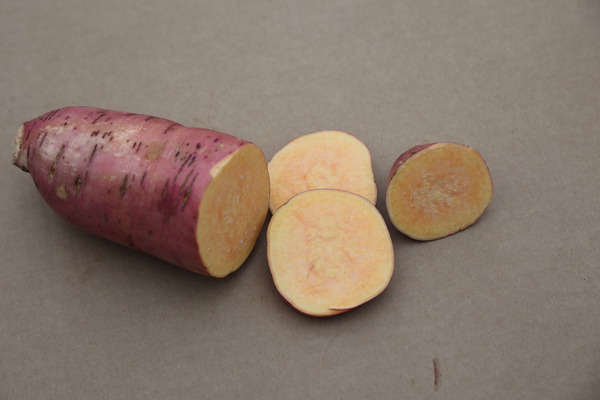
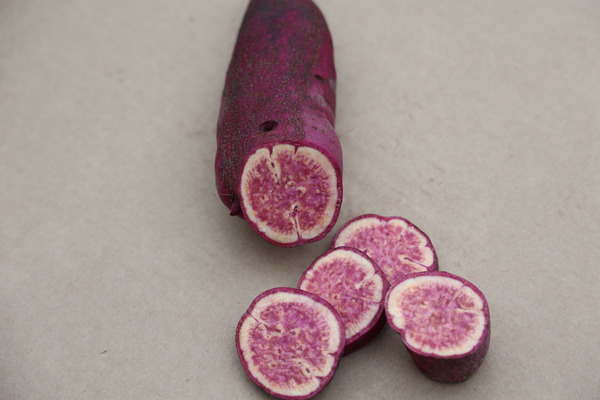
Pictures: The variety of colour combinations (inside & outside) finds hardly any limits
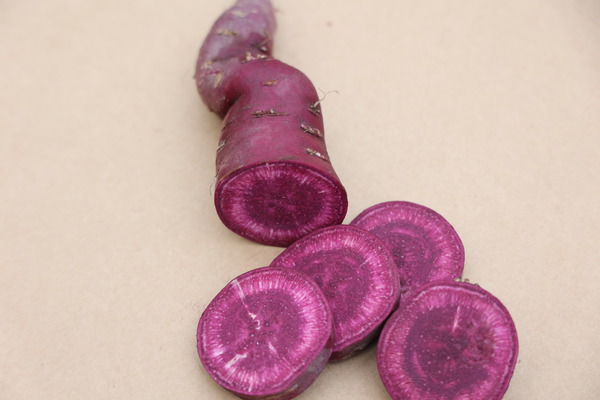
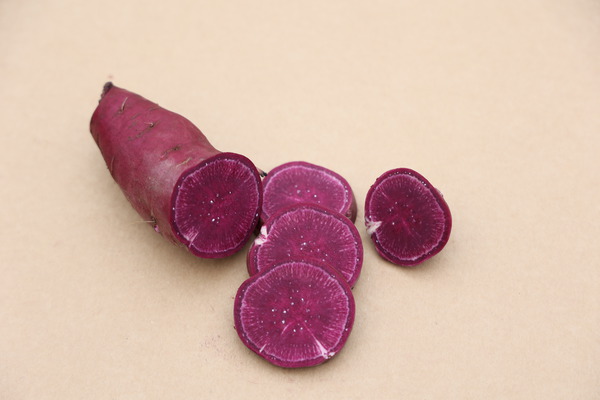
Pictures: The selections with purple tubers also show different intensities of colouring or marbling.
Diversity of the fruit texture and flavour
Tasting sweet potato varieties is a real pleasure – there is no other way to put it! But it is also a challenge for the tongue, palate and linguistic ability. The sweet potatoes are not only to be tasted, smelled and sniffed; after all, the results must also be put into words. So what do sweet potatoes taste like? (It should be noted that for tasting purposes we bake sweet potato slices of about 1 cm thickness in the oven until soft and then taste them lukewarm).
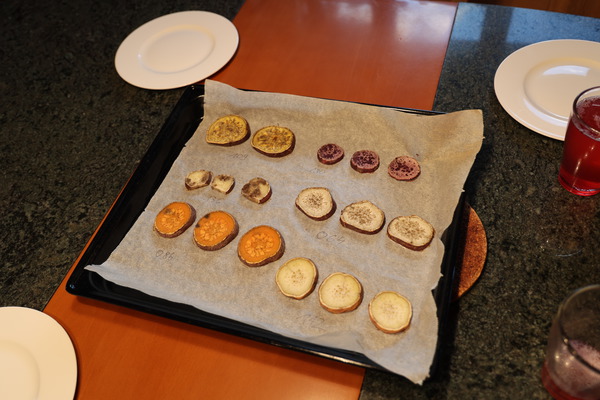
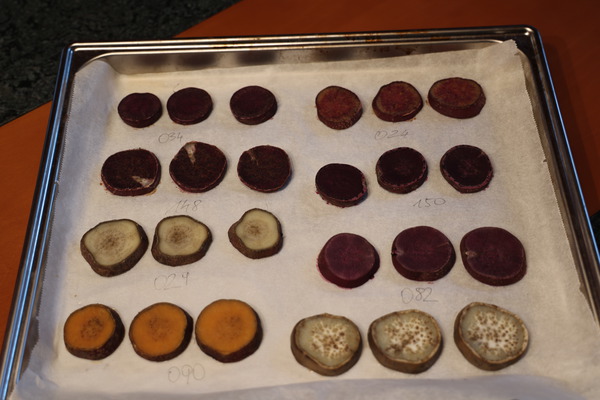
Pictures: The first tasting rounds
The first thing we notice is the texture, which can be grainy to mealy, or rather dry, in the case of varieties and genotypes with a high dry matter content. The moister varieties are more pleasant, which feel fine and not grainy and which melt on the tongue. 'Creamy' would also be a word, with sweet potato mash being more viscous in the mouth than a soup or sauce (which can also be creamy). After the texture, the second thing we certainly notice is the sugar, which increases from the starch reserves during the cooking and simmering process. Varieties for frying in particular tend to be lower in sugar, but we like to position the sweet potato rather away from the potato and tend to prefer sweeter varieties. The aim is not to accumulate sugar in quantities, but also to enhance additional flavour characteristics. Sweet potatoes can have a vegetable flavour, which invites further seasoning; yellow- and orange-fleshed varieties in particular can also be “sweet vegetable”, with clear hints of carrots, sometimes chestnuts. But we also find varieties with floral and fruity aromas. Some varieties are striking, with flavours reminiscent of lychee. And what about black chocolate? We have found violet breeding material with a distinct taste of black chocolate (including the bitter aftertaste) and also of brown chocolate...
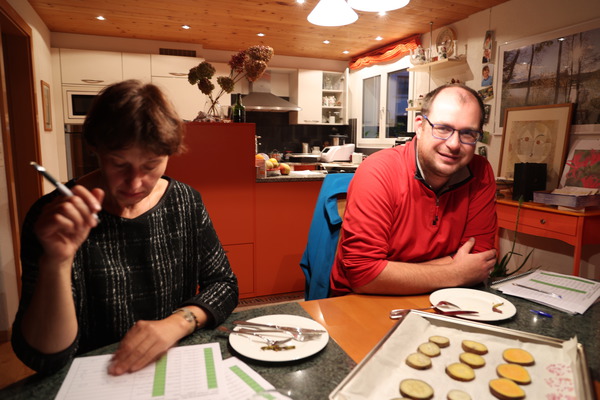
Picture: Two thirds of the tasting team: Magda Kobelt and Frederik Vollert. The third member of the team, Markus Kobelt, is behind the camera.
What is the next step for the Lubera sweet potato breeding programme?
After a few years of sweet potato breeding we are only at the beginning, but we are already seeing the first results. In the spring, we will introduce a small series of genuinely sweet potatoes at Lubera.com. A second batch of varieties will then be available in about two to three years; here we can expect improved ornamental varieties with more aromas and yield, but also some new flavour varieties in the entire colour spectrum, especially in the dark purple range. Due to the Central European breeding location in Rheintal, Switzerland, we automatically select varieties that can cope with a cooler, rainy climate, even in the summer, and ones that are ready to be harvested early. Our goal is to breed varieties that can be harvested from early to mid-September, but that can also stay in the soil longer when grown in a garden, gaining weight in the process and not starting to rot and sprout again. The diversity of this wonderful root crop still holds an infinite number of secrets that must first be uncovered through breeding.
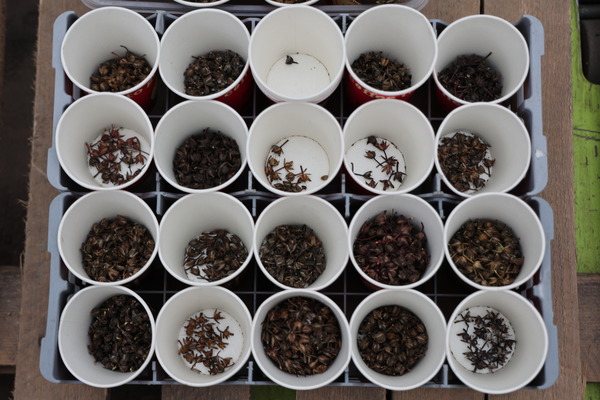
Picture: Sweet potato breeding continues - part of the sweet potato seeds harvested this year
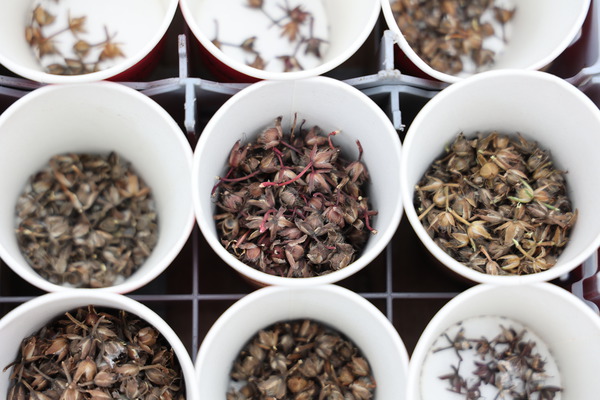
Picture: Close-up of the sweet potato seeds
